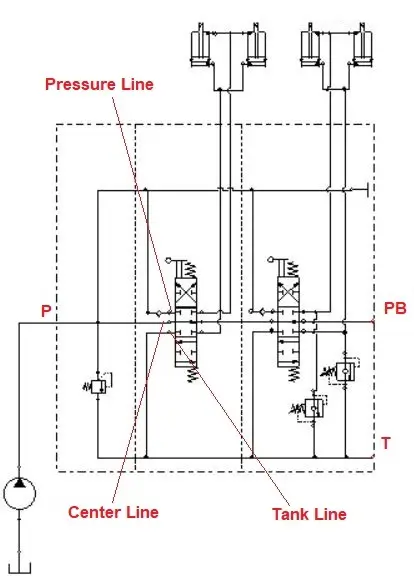Last updated on June 8th, 2025 at 02:31 pm
Power beyond is a feature that might not always get the attention it deserves, but it’s a game-changer when it comes to getting the most out of your equipment.
Whether you’re working with a tractor, backhoe loader, or log splitter, knowing how power beyond works can make a big difference in how you operate. In this post, I’ll make it as simple as possible, braking down what power beyond is, why it’s so useful, and how it can help you take your machine’s performance to the next level.
What is Power Beyond?
Let’s say you’ve just bought a tractor, and now you want to add a loader attachment. The problem is, you need to add flow to the loader while still keeping the tractor running smoothly. This is where power beyond comes into play.
Power beyond is a feature in hydraulic valve blocks that allows you to add extra functions or attachments to your machine without interrupting its main operations. Many manufacturers include power beyond in the valve block design to solve this very problem.
It basically gives you the option to connect an additional valve or attachment to your machine’s hydraulic system, so you can run multiple hydraulic functions at once.
Power beyond is also known as “High Pressure Carry Over (HPCO)”—a more technical term, but both mean the same thing.
How Does Power Beyond Work?
In a typical hydraulic system, you have a valve that controls the flow of fluid to different parts of your equipment.
With a standard valve, once the fluid returns to the tank, it can’t be reused by another function.
But with power beyond, things work differently. It reroutes the pressurized fluid to another valve, letting you use it for another task—like operating a loader, hammer, or any other attachment—without affecting the primary operation of the tractor.
In short, power beyond allows your machine to keep running smoothly, even when you add extra components.
A Practical Example
To really understand how power beyond works, let’s compare a hydraulic system with and without this feature.

Fig. 1 : Hydraulic Schematic without Power Beyond Feature
Without Power Beyond Feature
In a standard hydraulic setup, like the one shown in the Fig. 1, we have a 4×3 section valve. In this setup, when the system is in neutral, fluid flows directly from the pressure port (P) to the tank port (T) through the relief valve. Once the fluid returns to the tank, it can’t be reused for another function, limiting what you can do with your hydraulic system.
With Power Beyond Feature
With power beyond, things work a bit differently. As shown in the Fig. 2, power beyond adds a third line into the valve, making it into a 6×3 section valve.
These valves has three internal pathways:
- Pressure Line: Carries the pressurized fluid.
- Tank Line: Returns fluid to the tank.
- Center Line: Allows fluid to flow through the valve to another downstream valve.

Fig. 2 : Hydraulic Schematic with Power Beyond Feature
When the valve is in the neutral position, all flow passes through the Power Beyond (PB) port. This flow can then be used for any additional implement operations you’ve added to your machine.
However, when the main valve block is engaged (when a primary operation is activated), the flow from the pump is directed toward the primary operation, and the return flow is sent back directly to the tank. During this time, the power beyond feature doesn’t work, as no flow is available for additional functions.
Practical Application of Power Beyond
Figure 3 shows Hammer is connected to Power Beyond port through Hammer Valve.
Figure 4 shows backhoe loader application, in which loader valve’s power beyond port is directed connected to the excavator valve’s pressure port, enabling both functions to operate efficiently.

Fig. 3 : Hammer Valve connected to Power Beyond Port of Loader Block

Fig. 4 : Excavator Block connected to Power Beyond Port of Loader Block
(Note: Hammer Valve shown in above Schematic is from Fluid Press)
Fig. 5 & 6 shows SD25 Valve Block from Walvoil, which can have Power Beyond Feature. You can checkout catalogue of the SD25 Valve Block from Walvoil
As seen from Fig. 6, ‘RE’ type of Outlet Cover have Power Beyond Feature, in which ‘C’ Port is a Power Beyond Port.

Fig. 5 : 3D View of SD25 Valve Block which has Power Beyond Feature

Fig. 6 : Outlet Cover of SD25 Valve Block from Walvoil which has Power Beyond Feature
Why Do You Need Power Beyond?
The main advantage of power beyond is that it lets you expand the capabilities of your machine. Whether you want to add new tools or functions—like a log splitter’s lift or a tractor’s hydraulic trailer tip—you can do so without overhauling the entire hydraulic system.
By using power beyond, you:
- Gain the ability to add new attachments.
- Avoid the cost of redesigning your equipment’s hydraulics.
- Ensure smooth and efficient operation of all functions.
Power beyond also helps prevent system overload, since it allows fluid to bypass the main control valve and flow directly to the new function you’re adding. This means your primary controls continue to work seamlessly, even as you introduce new tools.
Conclusion
In the end, having power beyond on your equipment not only makes your machine more versatile but also ensures you can tackle more tasks efficiently without having to worry about complicated hydraulic setups. If you’re thinking of expanding what your machine can do, power beyond is definitely worth considering.
If you enjoyed this post, I’d really appreciate it if you could subscribe. I’m 100% planning to dive deep into hydraulics and break it down into simple terms for you!
